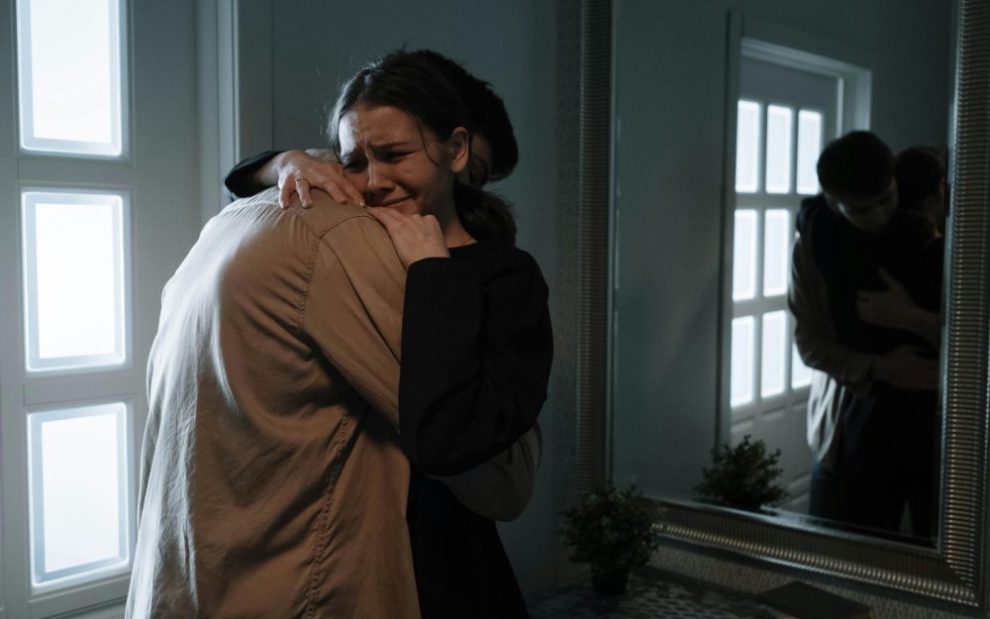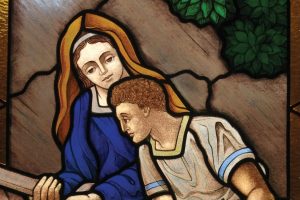Our local pandemic lockdown had been in effect for over a month on April 26, 2020. My two daughters had returned from college to finish their semesters, and my son Quentin was less than a month away from his high school graduation. Our family had turned on ESPN to watch the second episode of The Last Dance, the documentary chronicling Michael Jordan’s final season with the Chicago Bulls.
A few minutes into the program, Quentin said goodnight. He went to his room to listen to music before going to bed as he usually did around this time. About an hour later, a police cruiser pulled up to our house. I greeted the officer, and he announced he had come for a wellness check on Quentin. We rushed to my son’s room where we found him dead by suicide.
Two days later, my family drove to my parish for a meeting I had never foreseen needing. Four people from the bereavement ministry sat with us to plan my son’s funeral.
I fretted someone might inquire into his cause of death. How would I answer? I was in no emotional condition to discuss it, especially because I had regularly heard official Catholic teaching eternally condemned people who die by suicide. I had also read disturbing reports of priests preaching cruel funeral homilies for victims of suicide. To my relief, no one asked. Instead, they gently walked us through the planning process, listened to our stories and prayed for our entire family, including Quentin.
In the ensuing months, I became awash in a sea of grief, guilt, and failure. What could I have done to prevent it? Where did I fall short as a father? How could I go on? Thankfully, I found skilled psychological and medical professionals, but I needed spiritual guidance to traverse the valley of the shadow of death. When I turned to my Catholic faith, I found almost nothing designed for the particular needs of survivors of suicide loss.
Deaths by suicide reach every community. According to the Centers for Disease Control, suicide numbers among the top 9 causes of death for people aged 10–64 and as the second leading cause of death for people aged 44 and under. Adults aged 75 and older have the highest suicide rates. With the prevalence of suicide deaths, parishes are certain to find occasions to minister to survivors of suicide loss. However, survivors are often left to grieve silently and without hope due to stigma and misunderstanding.
My feelings of stigma involved ruminating over the possibility of someone asking about details of Quentin’s death. It plagued my every social interaction. Dreading the stares of busybodies who might judge him or our family over his cause of his death eroded my sleep. Sensing my friends needed to tiptoe around my emotional condition in our conversations, I would interject to put them at ease. My heart thrummed with consternation as I felt compelled to reassure them while I mourned. Even now, my jaw clenches when I imagine anyone might suppose Quentin is suffering perdition because of how he died.
There had to be a way for the church to speak into the dark night of my soul.
My parish’s grief ministry offered a bereavement support group. Although everyone was compassionate, nothing addressed my specific situation as a survivor. So, I began cobbling together a haphazard do-it-yourself program of Catholic spiritual care.
Praying with the Pietà, I identified with Mary cradling her son as I had embraced mine. Imaginative prayer with Biblical narratives, especially the raising of Jairus’s daughter, nurtured hope in my sorrow.
Reading the Catechism allayed my doctrinal concerns about suicide. The church’s teaching differs from prevalent misconceptions: “We should not despair of the eternal salvation of persons who have taken their own lives. By ways know to him alone, God can provide the opportunity for salutary repentance. The church prays for people who have taken their own lives.”
I began pressing my hand against my chest as the church prayed for Quentin during every Mass. “Remember also our brothers and sisters who have fallen asleep in the hope of the resurrection and all who have died in your mercy: welcome them into the light of your face.” I even wrote Pope Francis, and the return letter assured me the Holy Father would pray for Quentin at the altar.
The sacraments were instrumental to my healing. I carried the weight of my perceived fault and inadequacy to confession. In holy matrimony my wife and I encountered phases of grace and resilience. We had each lost our son, but we grieved differently. An amalgam of tears, helplessness, and anger created an ineffable intimacy we had never known before. Gradually, a mysterious strength emerged and our personal anguish became more bearable as we carried our mutual pain together.
About three years later, a close friend lost her husband to suicide. We shared stories of shock, confusion, and heartache. Sometimes, we sat in the knowing silence only survivors comprehend. Accompanying my friend awakened a yearning in me to assist others who mourned the suicide death of their loved ones.
I approached my parish’s volunteer coordinator, Linda Popolano, about the possibility of organizing a support group for survivors. We discussed how it might connect with the parish’s grief ministry, and she encouraged me to research what might be involved. I had no idea how to begin, so I went back to the internet. That’s when I discovered Deacon Ed Shoener.
Deacon Ed had founded the Association of Catholic Mental Health Ministers following his daughter Katie’s tragic death by suicide. The Association’s website supplies resources, tools, and best practices for forming a Catholic mental health ministry.
He had partnered with Bishop John Dolan of Phoenix, who is a survivor, to write two books responding to suicide loss. They had also produced an eight episode video series called When a Loved One Dies By Suicide. Each session features Catholic survivors, including clergy, who share their experiences of loss, learning to cope, and moving forward with confidence. I believed these films would structure our group meetings, but I had questions.
I reached out to Deacon Ed. He listened to my story and desire to support other survivors, and he assured me the video series had been successfully implemented in other parish settings. He emphasized this endeavor must be a ministry of spiritual accompaniment of love, not an alternative for therapy.
Linda then scheduled a time for me to present the idea to our parish pastor, Father Kirk Slattery and Deacon Dave Geislinger, who oversees our grief ministry. They quickly recognized how accompanying survivors would complement the parish’s mission to serve our community with Christ’s love.
We selected the 19th Sunday in Ordinary Time to announce the group. In the first reading, Elijah reaches his breaking point. “This is enough, O LORD! Take my life, for I am no better than my fathers.” Deacon Dave preached on suicide, mental health, and the necessity for the church to minister compassionately. I observed people moved to tears as they heard suicide mentioned from the ambo with such tender sensitivity.
When the group met, When a Loved One Dies by Suicide served as a springboard for conversation. Our losses were unique, so we resonated with the specific topics in different ways. Through poignant sessions of exploring suicide and Catholic faith, we found solace as we encountered fellow Catholics who had fathomed the pain, emptiness, and confusion we felt. And we witnessed how the faith could contribute to our healing.
While grief never entirely vanishes, having a community that openly explored the losses of suicide in relation to our faith created an inner space to develop post-traumatic growth. We came to describe our group as “a club no one wants to belong to,” but we were grateful to have found each other. Participants concurred that hearing clergy share their personal stories and clarify Catholic doctrine helped to lessen the weight of stigma common among survivors. Their courage modeled healing, not by denying grief but by sharing, integrating and honoring it. The survivor’s group has since become a vital part of our parish’s grief ministry.
By some combination of grace, desperation, and perseverance I waded through my grief to find a way to launch this group. Not everyone will have that capacity when they face such a challenging moment, nor should they. That’s why many parishes need to be ready to offer support.
I personally found meaning in these particular resources, but there are probably others out there. Whatever the case, parishes need to be aware that addressing suicide during Mass is essential. Pastors can elucidate Catholic teaching and correct misunderstandings. Mentioning survivors and their deceased loved ones in the prayers of the faithful models the spiritual work of mercy to pray for the living and the dead. All this gives credence to the parish’s commitment of supporting survivors, many of whom may have mourned secretly for years.
The principal element in any ministry to survivors of suicide loss is a compassionate commitment to travel with them on their journey through a grief unlike any other.
Image: Pexels/Cottonbro Studios












Add comment